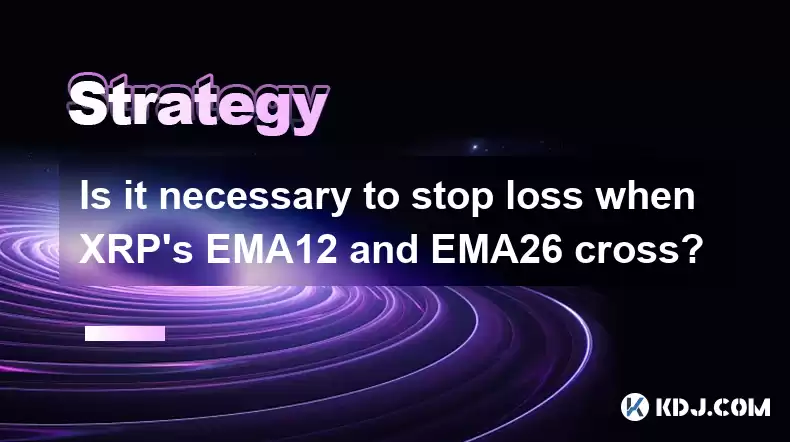-
 bitcoin
bitcoin $107208.295278 USD
-1.54% -
 ethereum
ethereum $3874.629914 USD
-1.38% -
 tether
tether $1.000440 USD
0.03% -
 bnb
bnb $1089.465513 USD
-5.53% -
 xrp
xrp $2.327672 USD
-1.65% -
 solana
solana $184.766505 USD
-0.73% -
 usd-coin
usd-coin $1.000076 USD
0.02% -
 tron
tron $0.310632 USD
-1.99% -
 dogecoin
dogecoin $0.187615 USD
-1.60% -
 cardano
cardano $0.633389 USD
-2.75% -
 ethena-usde
ethena-usde $0.999553 USD
0.03% -
 hyperliquid
hyperliquid $35.608231 USD
-4.13% -
 chainlink
chainlink $16.876114 USD
-3.98% -
 stellar
stellar $0.312239 USD
-0.91% -
 bitcoin-cash
bitcoin-cash $473.262969 USD
-7.09%
Is it necessary to stop loss when XRP's EMA12 and EMA26 cross?
When XRP's EMA12 and EMA26 cross, setting a stop loss can be crucial for managing risk, depending on market conditions and trader strategy.
Apr 26, 2025 at 03:57 pm

The Exponential Moving Average (EMA) is a popular technical indicator used by traders to analyze market trends and make trading decisions. When it comes to XRP, two commonly used EMAs are the EMA12 and EMA26. The crossing of these two EMAs can signal potential changes in the market trend, leading many traders to wonder if a stop loss should be implemented at such times. This article will explore the necessity of setting a stop loss when XRP's EMA12 and EMA26 cross, providing a detailed analysis of the scenario and offering insights into effective trading strategies.
Understanding EMA12 and EMA26
EMA, or Exponential Moving Average, is a type of moving average that places a greater weight on the most recent data points. The EMA12 and EMA26 are calculated over 12 and 26 periods, respectively. When these two EMAs cross, it is often considered a significant event in technical analysis.
- EMA12 crossing above EMA26 is known as a bullish crossover, suggesting that the market may be entering an uptrend.
- EMA12 crossing below EMA26 is known as a bearish crossover, indicating that the market may be entering a downtrend.
These crossovers are widely used in trading strategies, particularly in the context of the Moving Average Convergence Divergence (MACD) indicator, which is derived from these two EMAs.
The Importance of Stop Losses in Trading
A stop loss is an order placed with a broker to buy or sell an asset when it reaches a certain price. It is designed to limit an investor's loss on a position. The use of stop losses is a critical risk management tool in trading, helping to protect capital from significant declines.
- Stop losses can prevent emotional decision-making by automatically closing a position at a predetermined level.
- They help traders manage their risk by capping potential losses, which is essential for long-term trading success.
Analyzing EMA12 and EMA26 Crossovers in XRP
When the EMA12 and EMA26 of XRP cross, it can be a signal for traders to take action. However, the necessity of setting a stop loss at this juncture depends on several factors, including the trader's risk tolerance, trading strategy, and market conditions.
- Bullish crossover: If the EMA12 crosses above the EMA26, a trader might consider entering a long position. Setting a stop loss below the crossover point can help manage risk if the market reverses.
- Bearish crossover: If the EMA12 crosses below the EMA26, a trader might consider entering a short position. A stop loss above the crossover point can limit losses if the market moves against the trader's position.
Factors to Consider Before Setting a Stop Loss
Before setting a stop loss based on an EMA12 and EMA26 crossover, traders should consider several factors:
- Market Volatility: High volatility can lead to false signals. A stop loss should be set with consideration of the current market volatility to avoid being stopped out prematurely.
- Time Frame: The effectiveness of EMA crossovers can vary depending on the time frame. Shorter time frames may generate more frequent signals, but they can also be less reliable.
- Confirmation: Traders often look for confirmation from other indicators or price action before acting on a crossover signal. This can help reduce the likelihood of acting on a false signal.
Implementing a Stop Loss for XRP Based on EMA Crossovers
If a trader decides to set a stop loss based on an EMA12 and EMA26 crossover in XRP, here is a detailed guide on how to do so:
Identify the Crossover: Monitor the XRP price chart to identify when the EMA12 crosses the EMA26. This can be done using a trading platform that supports technical analysis.
Determine the Stop Loss Level: For a bullish crossover, set the stop loss below the crossover point. For a bearish crossover, set the stop loss above the crossover point. The exact level will depend on the trader's risk tolerance and market conditions.
Place the Stop Loss Order: Use the trading platform's order entry system to place a stop loss order at the determined level. Here are the steps:
- Log into your trading platform.
- Navigate to the XRP trading pair.
- Select the option to place a new order.
- Choose 'Stop Loss' as the order type.
- Enter the stop loss price based on your analysis.
- Confirm the order.
Monitor and Adjust: Continuously monitor the market and be prepared to adjust the stop loss if necessary. As the price moves in your favor, consider trailing the stop loss to lock in profits.
The Role of Risk Management in EMA-Based Trading
Risk management is crucial when using EMA crossovers to trade XRP. While the EMA12 and EMA26 can provide valuable signals, they are not foolproof. Traders should always have a comprehensive risk management strategy in place, which includes the use of stop losses but also considers position sizing, diversification, and other risk mitigation techniques.
- Position Sizing: Determine the size of your position based on your overall trading capital and the risk you are willing to take on each trade.
- Diversification: Spread your investments across different assets to reduce the impact of any single trade on your portfolio.
- Other Risk Mitigation Techniques: Consider using other technical indicators, fundamental analysis, and market sentiment to inform your trading decisions.
Real-World Examples of EMA Crossovers and Stop Losses
To illustrate the practical application of setting stop losses based on EMA12 and EMA26 crossovers, let's look at a few hypothetical examples involving XRP:
- Example 1: Bullish Crossover
- XRP's EMA12 crosses above the EMA26 at a price of $0.50.
- A trader enters a long position at $0.51.
- The trader sets a stop loss at $0.49, just below the crossover point.
- If the price drops to $0.49, the stop loss is triggered, limiting the trader's loss.
- Example 2: Bearish Crossover
- XRP's EMA12 crosses below the EMA26 at a price of $0.60.
- A trader enters a short position at $0.59.
- The trader sets a stop loss at $0.61, just above the crossover point.
- If the price rises to $0.61, the stop loss is triggered, limiting the trader's loss.
These examples demonstrate how stop losses can be used to manage risk when trading XRP based on EMA crossovers.
FAQs
Q1: Can I use other technical indicators in conjunction with EMA12 and EMA26 crossovers to improve my trading strategy?Yes, combining EMA12 and EMA26 crossovers with other technical indicators can enhance your trading strategy. For example, using the Relative Strength Index (RSI) to identify overbought or oversold conditions, or the Bollinger Bands to gauge volatility, can provide additional confirmation before entering or exiting trades.
Q2: How do I choose the right time frame for analyzing EMA crossovers in XRP?The choice of time frame depends on your trading style and objectives. Short-term traders might use 15-minute or 1-hour charts, while swing traders might prefer 4-hour or daily charts. Longer-term investors might look at weekly or monthly charts. Each time frame can provide different insights, so it's important to align your analysis with your trading goals.
Q3: Is it possible to trade XRP profitably without using stop losses?While it is possible to trade without stop losses, it is generally not advisable. Stop losses are a key component of risk management, helping to protect your capital from significant losses. Trading without them increases the risk of substantial drawdowns, which can be detrimental to your trading account.
Q4: How often should I review and adjust my stop loss orders when trading XRP?You should review your stop loss orders regularly, ideally on a daily basis or whenever there is a significant market event. Adjusting your stop losses as the market moves can help you lock in profits and manage risk more effectively.
Disclaimer:info@kdj.com
The information provided is not trading advice. kdj.com does not assume any responsibility for any investments made based on the information provided in this article. Cryptocurrencies are highly volatile and it is highly recommended that you invest with caution after thorough research!
If you believe that the content used on this website infringes your copyright, please contact us immediately (info@kdj.com) and we will delete it promptly.
- Jupiter Exchange's Ultra V3: A New Era for Solana Trading
- 2025-10-18 16:25:12
- Investors, Centralization Risks, and Top Coins: Navigating the Crypto Landscape
- 2025-10-18 16:45:16
- Uniswap, Solana, and Liquidity: Bridging the DeFi Divide
- 2025-10-18 16:45:16
- Bitcoin Price Target: Analysts Eye $125K Amidst Market Jitters
- 2025-10-18 16:50:13
- Solana, ADA, SUI: Navigating the Altcoin Landscape in a Shifting Market
- 2025-10-18 16:50:13
- DOGE Price Recovery: Is a Major Rally on the Horizon?
- 2025-10-18 16:55:12
Related knowledge

Practical parameter settings for a Bitcoin multi-timeframe moving average system
Sep 18,2025 at 10:54pm
Optimizing Timeframe Combinations for Bitcoin Trading1. Selecting appropriate timeframes is crucial when building a multi-timeframe moving average sys...

How can I filter out false breakouts in Dogecoin high-frequency trading?
Sep 22,2025 at 01:00am
Understanding False Breakouts in Dogecoin Trading1. A false breakout occurs when Dogecoin's price appears to move beyond a defined support or resistan...

Techniques for identifying tops and bottoms in the Bitcoin on-chain NVT model
Sep 20,2025 at 07:54pm
Understanding the NVT Model in Bitcoin Analysis1. The Network Value to Transactions (NVT) ratio is often described as the 'P/E ratio' of the cryptocur...

What does the surge in open interest in Bitcoincoin futures mean?
Sep 20,2025 at 11:18pm
Understanding the Surge in Dogecoin Futures Open Interest1. A surge in open interest within Dogecoin futures indicates a growing number of active cont...

How can I use the Ethereum USDT premium to gauge market sentiment?
Sep 18,2025 at 11:55pm
Understanding the Ethereum USDT Premium1. The Ethereum USDT premium refers to the price difference between USDT (Tether) traded on Ethereum-based plat...

What should I do if Ethereum staking yields decline?
Sep 20,2025 at 06:18am
Understanding the Causes Behind Declining Ethereum Staking Yields1. The Ethereum network transitioned to a proof-of-stake consensus mechanism with the...

Practical parameter settings for a Bitcoin multi-timeframe moving average system
Sep 18,2025 at 10:54pm
Optimizing Timeframe Combinations for Bitcoin Trading1. Selecting appropriate timeframes is crucial when building a multi-timeframe moving average sys...

How can I filter out false breakouts in Dogecoin high-frequency trading?
Sep 22,2025 at 01:00am
Understanding False Breakouts in Dogecoin Trading1. A false breakout occurs when Dogecoin's price appears to move beyond a defined support or resistan...

Techniques for identifying tops and bottoms in the Bitcoin on-chain NVT model
Sep 20,2025 at 07:54pm
Understanding the NVT Model in Bitcoin Analysis1. The Network Value to Transactions (NVT) ratio is often described as the 'P/E ratio' of the cryptocur...

What does the surge in open interest in Bitcoincoin futures mean?
Sep 20,2025 at 11:18pm
Understanding the Surge in Dogecoin Futures Open Interest1. A surge in open interest within Dogecoin futures indicates a growing number of active cont...

How can I use the Ethereum USDT premium to gauge market sentiment?
Sep 18,2025 at 11:55pm
Understanding the Ethereum USDT Premium1. The Ethereum USDT premium refers to the price difference between USDT (Tether) traded on Ethereum-based plat...

What should I do if Ethereum staking yields decline?
Sep 20,2025 at 06:18am
Understanding the Causes Behind Declining Ethereum Staking Yields1. The Ethereum network transitioned to a proof-of-stake consensus mechanism with the...
See all articles























![[4K 60fps] 5upreme by RoyalP (1 coin) [4K 60fps] 5upreme by RoyalP (1 coin)](/uploads/2025/10/18/cryptocurrencies-news/videos/k-fps-upreme-royalp-coin/68f2e6c9ef491_image_500_375.webp)


















































